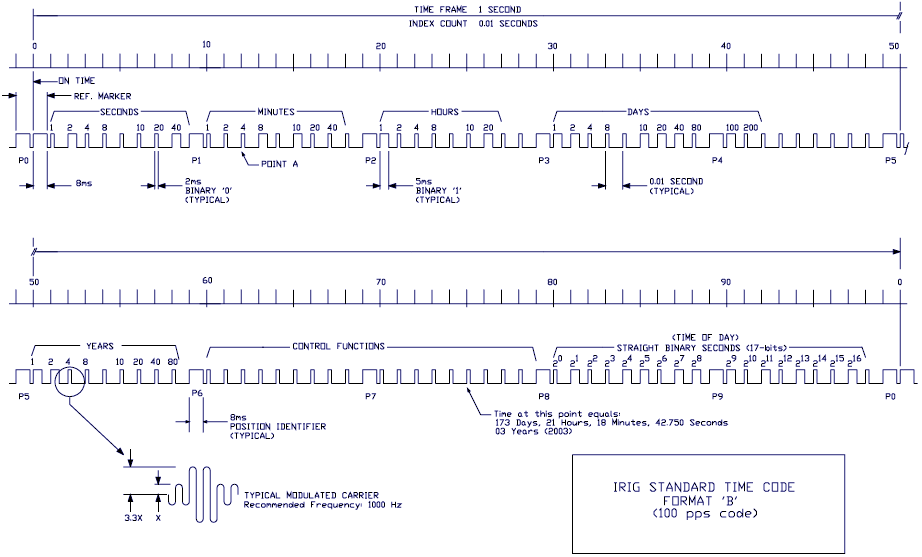IRIG B Output
The IRIG B Time Code description follows.

IRIG B time code description
The IRIG B code contains the Binary Coded Decimal (BCD) time of year, Control Function (CF) field and the Straight Binary Seconds time of day. The following figure illustrates the IRIG B data structure. The BCD time of year provides the day of the year, 1-366, and the time of day including seconds. The hour of the day is expressed in 24 hour format. The SBS time is the number of seconds elapsed since midnight. The Control Function field contains year information and a time synchronization status bit.
- Time frame: 1.0 seconds.
- Code digit weighting:
- Binary Coded Decimal time-of-year.
- Code word - 30 binary digits.
- Seconds, minutes hours, and days.
- Recycles yearly.
- Straight Binary Seconds time-of-day.
- Code word - 17 binary digits.
- Seconds only, recycles daily.
- Code word structure:
- BCD: Word seconds digits begin at index count 1. Binary coded elements occur between position identifier elements P0 and P5 (7 for seconds, 7 for minutes, 6 for hours, and 10 for days) until the code word is complete. An index marker occurs between decimal digits in each group to provide separation for visual resolution. Least significant digit occurs first.
- CF: IRIG formats reserve a set of elements known as Control Functions (CF) for the encoding of various control, identification, or other special purpose functions. IRIG B has 27 Control Functions located between elements 50 and 78. The NetClock uses the Control Functions to encode year information and time synchronization status.
The table below lists the Control Function Field and the function of each element.
- Element 55 is the time synchronization status bit. Element 55 is a Binary 1 when the unit is in sync, and a Binary 0 when it is not.
- Year information consists of the last two digits of the current year (i.e. 97, 98, 99 etc.). Elements 60 through 63 contain the binary equivalent of year units. Elements 65 through 68 contain the binary equivalent of tens of years. In keeping with IRIG formats, the least significant bit occurs first. All unused Control Functions are filled with a space (Binary 0).
- SBS: Word begins at index count 80. Seventeen Straight Binary Coded elements occur with a position identifier between the 9th and 10th binary coded elements. Least significant digit occurs first.
- Pulse rates:
- Element rate: 100 per second.
- Position identifier rate: 10 per second.
- Reference marker rate: 1 per second.
- Element identification: The "on time" reference point for all elements is the pulse leading edge.
- Index marker (Binary 0 or uncoded element): 2 millisecond duration.
- Code digit (Binary 1): 5 millisecond duration.
- Position identifier: 8 millisecond duration.
- Reference marker, 1 per second. The reference marker appears as two consecutive position identifiers. The second position identifier marks the on-time point for the succeeding code word.
- Resolution:
- Pulse width coded signal: 10 milliseconds.
- Amplitude modulated signal: 1 millisecond.
- Carrier frequency: 1kHz when modulated.
IRIG B control function field
| C.F. Element # | Digit # | Function |
|---|---|---|
| 50 | 1 | Space |
| 51 | 2 | Space |
| 52 | 3 | Space |
| 53 | 4 | Space |
| 54 | 5 | Space |
| 55 | 6 | Time Sync Status |
| 56 | 7 | Space |
| 57 | 8 | Space |
| 58 | 9 | Space |
| 59 | PID P6 | Position Identifier |
| 60 | 10 | Years Units Y1 |
| 61 | 11 | Years Units Y2 |
| 62 | 12 | Years Units Y4 |
| 63 | 13 | Years Units Y8 |
| 64 | 14 | Space |
| 65 | 15 | Years Tens Y10 |
| 66 | 16 | Years Tens Y20 |
| 67 | 17 | Years Tens Y40 |
| 68 | 18 | Years Tens Y80 |
| 69 | PID P7 | Position Identifier |
| 70 | 19 | Space |
| 71 | 20 | Space |
| 72 | 21 | Space |
| 73 | 22 | Space |
| 74 | 23 | Space |
| 75 | 24 | Space |
| 76 | 25 | Space |
| 77 | 26 | Space |
| 78 | 27 | Space |